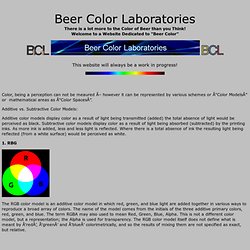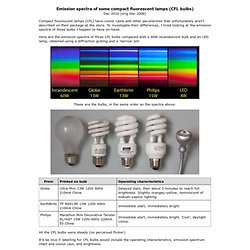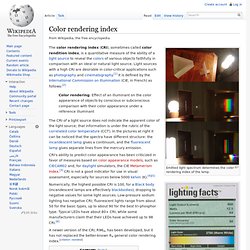

Color. Color, being a perception can not be meaured – however it can be represented by various schemes or “Color Models” or mathematical areas as “Color Spaces”.

Additive vs. Subtractive Color Models: Color Basics. DIY Spectrometer, and notes on online Spectral Workbench. There exist several variations of DIY spectrometer by using CD or DVD as the main component (ie. generating the rainbow of colors by diffraction from the optical disk grooves).

The output is a spectra, light intensity versus wavelength. In Wikipedia: Diffraction refers to various phenomena which occur when a wave encounters an obstacle. The most striking examples of diffraction are those involving light; for example, the closely spaced tracks on a CD or DVD act as a diffraction grating to form the familiar rainbow pattern seen when looking at a disk.In optics, a diffraction grating is an optical component with a periodic structure, which splits and diffracts light into several beams travelling in different directions. Portable version The portable version is for visual detection. The viewpoint is from behind about at the right angle to DVD. An example spectra of CFL is taken with this setup, is shown below. Webcam version. Emission spectra of some compact fluorescent lamps. Emission spectra of some compact fluorescent lamps (CFL bulbs) Dec 2010 (orig Dec 2006) Compact flourescent lamps (CFL) have colour casts and other peculiarities that unfortunately aren't described on their package at the store.

To investigate their differences, I tried looking at the emission spectra of three bulbs I happen to have on-hand. Here are the emission spectra of three CFL bulbs compared with a 60W incandescent bulb and an LED lamp, obtained using a diffraction grating and a 'narrow' slit: These are the bulbs, in the same order as the spectra above: All the CFL bulbs were steady (no perceived flicker). It'd be nice if labelling for CFL bulbs would include the operating characteristics, emission spectrum chart and colour cast, and brightness. Some CFLs are labelled with a 'temperature', in degrees Kelvin, but of course a continuous-spectrum black-body-radiation profile would be only a very rough approximation of the discontinuous spectra emitted by any of the CFL bulbs here. Color temperature. The color temperature of a light source is the temperature of an ideal black body radiator that radiates light of comparable hue to that of the light source.

Color temperature is a characteristic of visible light that has important applications in lighting, photography, videography, publishing, manufacturing, astrophysics, horticulture, and other fields. In practice, color temperature is only meaningful for light sources that do in fact correspond somewhat closely to the radiation of some black body, i.e. those on a line from reddish/orange via yellow and more or less white to blueish white; it does not make sense to speak of the color temperature of e.g. a green or a purple light. Color rendering index. Emitted light spectrum determines the color rendering index of the lamp.

Color rendering index shown as Color Accuracy. The color rendering index (CRI), sometimes called color rendition index, is a quantitative measure of the ability of a light source to reveal the colors of various objects faithfully in comparison with an ideal or natural light source. Light sources with a high CRI are desirable in color-critical applications such as photography and cinematography.[1] It is defined by the International Commission on Illumination (CIE, in French) as follows:[2]
Color temperature. The color temperature of a light source is the temperature of an ideal black body radiator that radiates light of comparable hue to that of the light source. Color temperature is a characteristic of visible light that has important applications in lighting, photography, videography, publishing, manufacturing, astrophysics, horticulture, and other fields.
In practice, color temperature is only meaningful for light sources that do in fact correspond somewhat closely to the radiation of some black body, i.e. those on a line from reddish/orange via yellow and more or less white to blueish white; it does not make sense to speak of the color temperature of e.g. a green or a purple light. Color temperature is conventionally stated in the unit of absolute temperature, the kelvin, having the unit symbol K. Categorizing different lighting[edit] The black-body radiance (Bλ) vs. wavelength (λ) curves for the visible spectrum. The Sun[edit] Photography.tutsplus. In this tutorial you'll see why setting your camera to the correct White Balance not only saves you a great deal of time in Photoshop, but also enhances image quality.

We'll talk about color temperatures, White Balance presets, and how they affect your photographs. Learning to read the light and set your camera accordingly is essential for all photographers, from beginners to the masters. 1. Equipment You don't necessarily need a professional Digital SLR to reap the benefits of adjusting your White Balance (WB). A digital camera with WB optionsThe Instruction/Operation Manual of your camera If you aren't sure about your camera's WB options, visit your camera manufacturer's website. 2. There are many image editors out there, but I will be using Adobe Photoshop. Also, whenever you post-process an image, you're throwing away information. 3.